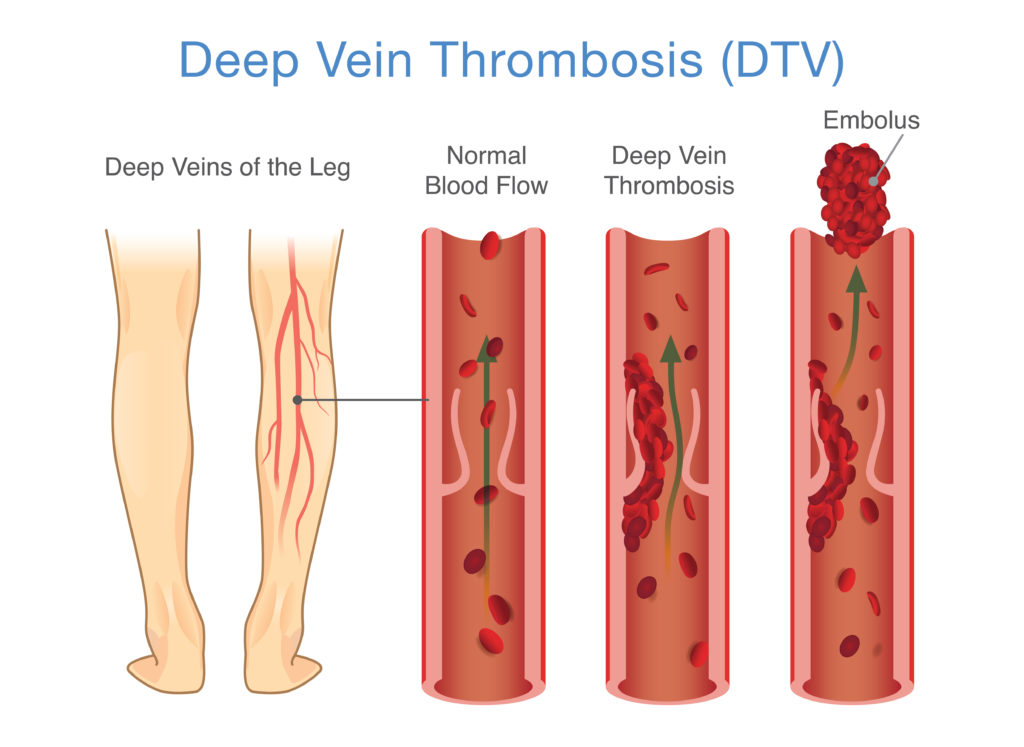Deep Venous Thrombosis

A deep venous thrombosis (DVT) is a blood clot that occurs in a deep vein. A DVT can form anywhere in the body, but it more frequently occurs in the calves or thighs.
Symptoms of a DVT
The symptoms associated with deep venous thrombosis vary widely. An individual with a blood clot may not have any symptoms. Or, a patient with a blood clot in the leg may experience warmth, redness, swelling, and pain in response to compression of the calf, or to passive flexion of the foot. A blood clot in the arm may cause neck pain, shoulder pain, swelling in the arm or hand, and weakness in the hand. However, the presence of any of these symptoms does not definitively indicate a blood clot. The symptoms can also be associated with other disorders including a blood clot in a superficial vein, a previous blood clot, trauma, cellulitis, lymphedema, or a Baker’s cyst behind the knee.
Risk Factors for Developing a DVT
Injury. Trauma to a limb can cause narrowing of blood vessels and reducing blood flow causing a blood clot to form.
Surgery. Blood vessels can be damaged during surgery resulting in impaired blood flow and the development of blood clots.
Weakness, paralysis, and reduced mobility including prolonged sitting can cause blood to pool in the veins and increase the chance of a blood clot forming.
Medications. Certain medications increase the risk of developing a blood clot and your health care provider should know all the drugs you take.
Active cancer.
Previous blood clot.
Hereditary blood clotting disorders.
Heavy smoking.
Pregnancy.
Diagnosis of a DVT
Your health care provider may suspect that you have a deep venous thrombosis based on a review of your medical history and an examination of your leg. They may order tests to confirm a blood clot. These tests could include:
An ultrasound of the affected leg. This is the most common test for diagnosing a DVT.
A blood test to determine if a blood clot is forming (D dimer test).
Thrombophilia testing to determine if you have an inherited, or an acquired predisposition to making blood clots.
Complications of a DVT
Pulmonary embolism (PE). A pulmonary embolism is a piece of a blood clot that breaks off and travels through the veins to the lungs. A pulmonary embolism is potentially life-threatening because it can impair blood flow through the lungs, and therefore, is the most important, potential complication of a deep venous thrombosis.
Post-thrombotic Syndrome. Post-thrombotic syndrome can occur weeks or months after having a blood clot. Symptoms can include various combinations of leg pain, heaviness, and fatigue, redness or dusky discoloration of the leg when it is lower than the heart, and swelling. Post-thrombotic syndrome is not curable, and treatment is directed at relieving symptoms. Compression stockings are oftentimes helpful.
Treatment of DVT
Blood thinners. Once you are diagnosed with a deep venous thrombosis, you will likely be prescribed a medication known as an anticoagulant, or a blood thinner, to keep the blood clot from growing, and prevent future clots from forming.
Compression garments. Compression stockings for the leg and compression sleeves for the arm may help control leg discomfort and swelling from the post-thrombotic syndrome.
Surgery. Special surgical procedures including catheter-directed thrombolytic therapy, and percutaneous mechanical thrombectomy, may be considered for very select patients, especially individuals at risk of losing a limb because of impaired blood flow.
Self-Help Interventions to Prevent and Treat DVT
If you smoke, quit.
Lose weight if you are overweight.
Avoid sitting for long periods of time. Get up and walk around often if you’re driving or on a long flight.
Don’t wear tight clothing when traveling long distances.
Exercise, such as walking, biking, or swimming every day.
Wear graduated compression stockings, especially after surgery or if you are on bed rest.
Drink plenty of fluids to stay hydrated.
If you have high blood pressure, make an attempt to lower it by reducing your salt intake. Your health care provider may also recommend blood pressure-lowering drugs if appropriate.
Final Words
Deep Venous thrombosis is a serious condition. Always follow your health care provider’s advice for the prevention and treatment of a blood clot, especially if you are at a higher risk for developing it. If you develop a blood clot, you can successfully manage it with anticoagulation medications and lifestyle changes. If you don’t treat a DVT, the clot can break loose and lodge in the small blood vessels of your lungs. This causes a dangerous condition known as pulmonary embolism. Call 911 or local emergency services right away if you have any signs of a pulmonary embolism. These include:
Chest pain that worsens when you cough or breath deeply.
Rapid breathing.
Coughing up blood.
Fast heart rate.
Dizziness.
 507-322-6967
507-322-6967